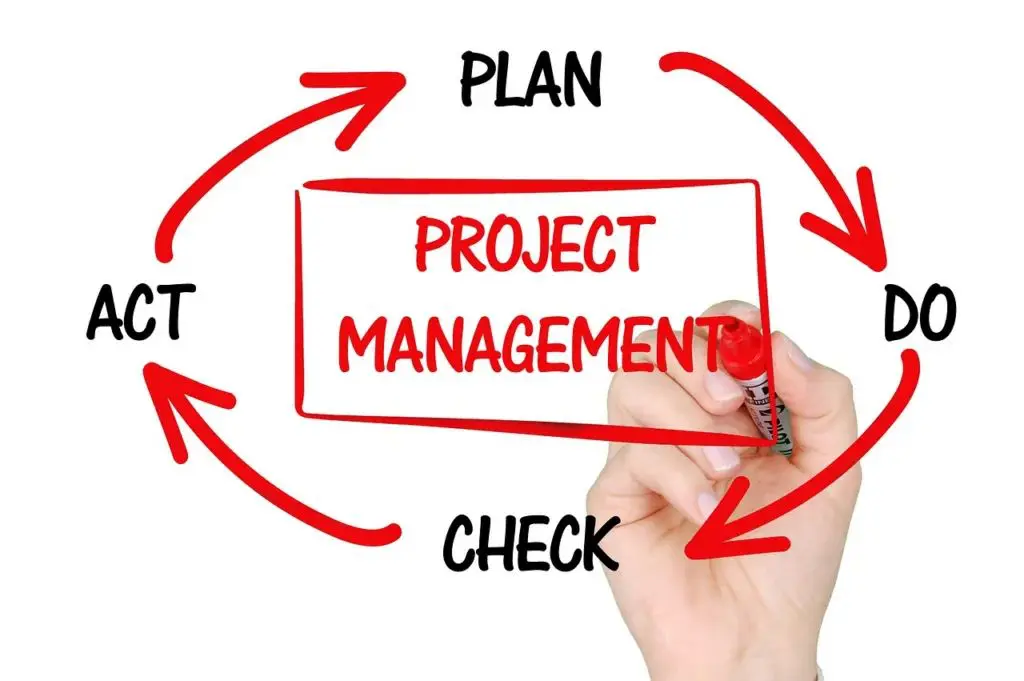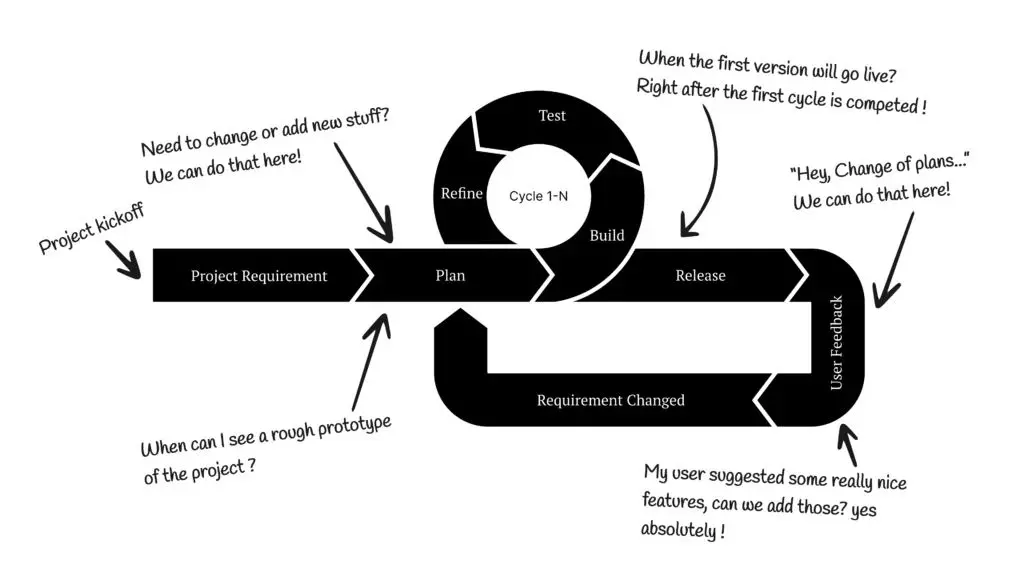Every business needs a systematic approach to conducting its operations. Each phase of a business’s operations has to be divided into tasks to ensure quality and successful completion. That is why we use project management to ensure each project goes through a pre-defined systematic framework while being managed and monitored carefully by the project team.
Project management is a discipline that has been around for so long, and therefore, standard practices have been developed through which organizations can easily manage their projects. These standard practices involve creating a project life cycle. But what is the best way to define a project life cycle in project management for your own specific projects?
Let’s find out in this blog the simplest 5 steps to create a project management life cycle.
Simple Explanation of Project Management
Project management is the discipline of planning, organizing, and overseeing the successful completion of a project within specific goals, constraints, and timelines. It involves the application of knowledge, skills, tools, and techniques to effectively manage resources, tasks, and stakeholders throughout the project life cycle.
Let’s simplify what actually is project management in layman’s terms!
Imagine you’re about to bake a delicious cake. You must gather all the ingredients, follow a recipe, and watch the oven timer. Well, project management is kind of like baking that cake! In project management, you have a goal or project you want to accomplish. Like gathering ingredients, you gather a team, resources, and a plan. You brainstorm ideas and decide how to make your project a success.
Next, you start implementing your plan, like mixing and baking the cake. You assign tasks to your team members and make sure everyone knows what they’re doing. You keep track of progress and make adjustments along the way.
Finally, when the cake is fully baked, you celebrate and enjoy the tasty results! Similarly, in project management, you reach the end of your project, tie up loose ends, document lessons learned, and celebrate your achievements.

What Is the Purpose of Project Life Cycle in Project Management?
The project life cycle in project management is the steps involved in a project from initiation to execution. It intends to provide a disciplined framework for managing projects from beginning to end. It aids in the execution of projects in a methodical and organized manner, with specified phases and deliverables.
The project life cycle in project management allows for better project management and control by breaking the project into separate phases. The project team’s efforts are guided by specified objectives, tasks, and outputs during each phase.
There are several project life cycle models, such as agile project management, scrum development strategy, lean software development, etc., that have specific ways of defining a project lifecycle. These models also make it easier to scale project teams at each life phase of the project life cycle in project management.
Roles in a Project Management Team
A project needs a project manager and a team of skilled individuals who are the right fit for the tasks. That’s how simple it is! However, the project manager has their own specific responsibilities, and the rest of the tasks are divided further within the team.
Project Manager
The responsibilities of a project manager can vary depending on the organization and project specifics, but here are some common responsibilities:
- Project Planning: Develop a comprehensive project plan.
- Team Management: Lead and assign tasks to the project team.
- Stakeholder Communication: Act as the main point of contact for stakeholders.
- Risk Management: Identify and mitigate project risks.
- Budgeting and Cost Control: Manage project budgets and expenses.
- Quality Assurance: Ensure project deliverables meet quality standards.
- Schedule Management: Develop and monitor project schedules.
- Change Management: Manage project changes effectively.
- Documentation and Reporting: Maintain project documentation and provide reports.
- Continuous Improvement: Analyze project performance and apply lessons learned.

Project Team
Similarly, a project team’s responsibilities vary on the nature of the project and scope of work. However, some common responsibilities can be:
- Execute assigned tasks within the project plan.
- Collaborate and communicate effectively.
- Contribute knowledge and expertise.
- Solve problems and propose solutions.
- Participate in decision-making processes.
- Identify and mitigate project risks.
- Ensure quality of work and deliverables.
- Engage in continuous learning and improvement.
- Adapt to changing project conditions.
- Deliver stakeholder satisfaction.

5 Steps of Project Life Cycle in Project Management
Let’s cover our main topic, the steps you must take in a project management life cycle. Usually, the phases of a project life cycle are standard. But here we are going to discuss the simplest project life cycle 5 phases that can be implemented on any type of project:
- Project Requirements Analysis
- Plan Project Management
- Release
- User Feedback
- Modifications

1- Project Requirements Analysis
The first step in the project management life cycle is project requirements analysis. During this phase, the project team identifies, gathers, and documents the project requirements. The team has to conduct thorough research, consult stakeholders, and understand the project’s objectives, scope, and constraints. Meanwhile, the project manager works closely with the team and stakeholders to clarify requirements, prioritize them, and ensure they align with the project’s overall goals.
2- Plan Project Management
A project cannot be initiated without creating a well-sought-out plan first. Under the “Plan Project Management” phase, there are three key parts: Build, Test, and Refine.
Build
The project team develops a detailed project plan that specifies the tasks, activities, and resources needed to complete the project effectively. The plan comprises deadlines, milestones, dependencies, and responsibility distribution. The project manager ensures that the plan is comprehensive and achievable within the limits that have been established.
Test
The testing phase focuses on confirming and ensuring the feasibility of the project plan. The project manager and team review the plan, looking for any hazards, gaps, or areas that need improvement. They undertake feasibility studies, test assumptions and the product’s usability, and analyze potential difficulties to ensure the strategy is sturdy and feasible.
Refine
The project plan is iterated and improved during the refinement stage depending on feedback, evaluations, and new information. The project manager and team make any necessary changes, fine-tune resource allocations, optimize the project schedule, and handle any issues or concerns that arise during the testing phase. The purpose is to improve the plan’s efficacy and raise the likelihood of project success.
3- Release
The project strategy is put into action during the release phase. It entails carrying out project operations, allocating resources, and supervising the team. The project manager coordinates and monitors progress, ensuring that tasks are completed on time, and any concerns or hazards are addressed as soon as possible. This stage may also include holding frequent project status meetings, tracking performance indicators, and communicating project progress to stakeholders.
4- User Feedback
The project team seeks input from end-users or stakeholders once the product is delivered or achieves a critical milestone. User input is essential for determining whether project deliverables match their expectations and requirements. The project manager gathers and analyzes input to determine user happiness, identify areas for development, and evaluate the project’s performance in relation to the original objectives. This feedback becomes useful information for the following phase.
5- Modifications
In the last step, the project team identifies essential modifications or upgrades to the project based on user feedback and constant monitoring. Implementing improvements, addressing any difficulties or concerns, and revising project deliverables are all part of this phase. The project manager works with the team to update the project plan, modify timeframes and resources as needed, and verify that any changes are consistent with the project’s goals. The user feedback and revisions cycle continues until the project is judged complete or the target state is reached.
Critical Elements of an Effective Project Management Life Cycle
Some elements in a project management life cycle are necessary to complete any project successfully. These elements also add value to your work and keep it streamlined. Read below carefully what is the meaning behind each element:
- Needs Identification
- Planning
- Collaboration
- Controlling
- Communication
Needs Identification
This is the initial and most important step in project management. It involves defining and comprehending the project’s needs, goals, and requirements. You can define clear objectives and ensure that the project corresponds with stakeholders’ expectations by carefully examining what needs to be accomplished.

Planning
Once the needs have been determined, it is time to develop a strong plan. Planning entails establishing the activities, milestones, schedules, and resources to fulfill project goals. It’s similar to gathering all ingredients, properly measuring them, and crafting a step-by-step recipe to follow. A well-thought-out strategy serves as a roadmap, directing the project team throughout the project’s life.

Collaboration
Effective teamwork is essential for successful project management. It involves creating a varied team with complementary talents and expertise and cultivating a cooperative and supportive environment. Collaboration allows team members to share ideas, information, and responsibilities, fostering innovation and synergy. It’s like a group of brilliant bakers working together to create a delicious cake, each with its own set of skills.

Controlling
Controlling includes monitoring project progress, tracking performance, and taking corrective steps as needed. It guarantees that the project continues on track, deadlines are met, and the anticipated outcomes are achieved. Just as a baker monitors the oven temperature and makes adjustments as needed, project managers utilize monitoring tools and procedures to keep the project under control, controlling risks and resolving issues as soon as they arise.

Communication
Throughout the project management life cycle, effective communication is critical. It entails the transparent and open sharing of information, ideas, and updates between team members, stakeholders, and other relevant parties. Good communication keeps everyone on the same page, clarifies roles and responsibilities, and promotes collaboration and alignment. It’s similar to having clear and friendly instructions for each cake recipe step, ensuring everyone knows what to do and can work together successfully.

Best Tools for Project Management
Project management has now become so much easier with advanced tools with a user-friendly interface available in the market. Many of these tools are free and have all the basic features required to manage, monitor, scale, and plan a project. Here is our list of the 10 best project management tools that will simplify every task of your project management life cycle:
- Asana
- Trello
- Jira
- Monday
- Microsoft Project
- Basecamp
- Wrike
- Smartsheet
- Miro
- Click Up
Asana
Asana is a versatile project management tool that offers task management, collaboration, and project tracking features. It provides a user-friendly interface and integrates well with other tools.
Trello
Trello is a visual project management tool that uses boards, lists, and cards to organize tasks and workflows. It is known for its simplicity and flexibility, making it suitable for personal and team use.
Jira
Jira is a comprehensive project management tool primarily used for software development projects. It offers features like issue tracking, agile planning, and team collaboration, making it popular among software development teams.
Monday
Monday.com is a project management tool that allows teams to plan, track, and collaborate on projects. It has several templates and interfaces with several other tools. Designers and Developers can both use this tool for their projects.
Microsoft Project
Microsoft Project is a robust tool with task scheduling, resource management, and Gantt chart visualization features. It is widely used in industries that require complex project planning and management.
Basecamp
Basecamp is an easy-to-use project management application that emphasizes team cooperation and communication. It provides a centralized platform for project collaboration with features such as task management, file sharing, and messaging.
Wrike
Wrike is a project management platform that allows teams to plan, collaborate, and measure progress in the cloud. It includes functions like task management, document sharing, and real-time reporting.
Smartsheet
Smartsheet is a collaborative work management platform that combines project management with spreadsheet functionality. It allows teams to plan, track, and automate workflows in a familiar spreadsheet-like interface.
Miro
Miro is an online collaborative whiteboard tool for project management, brainstorming, visual planning, and team communication. It enables groups to design and share diagrams, mind maps, user flows, and other visual assets. Although Miro is not a standard project management tool, it is frequently used in conjunction with other project management platforms to improve visual collaboration and facilitate ideation and planning processes.
Click Up
ClickUp is a project management software that integrates task management, collaboration, and automation capabilities. It has a customizable UI and works with a variety of third-party applications.
Conclusion
As we’ve learned, project management is one of the most important disciplines in running successful business operations. You cannot create a successful project without this systematic process. Any type of organizational project requires careful planning, a motivated and skilled team, an accomplished project manager, and the right tools.
Your project management life cycle will ensure that your project runs smoothly, provides the required outcomes, and achieves quality as desired. Another great benefit of the project lifecycle in project management is that you can measure the performance at each stage and take necessary steps to improve or appreciate it in the future. So make sure to take your project life cycle seriously!
FAQs
Why do we need project management?
Project management is essential because it provides structure, organization, and oversight to ensure success. It aids in defining project goals, resource allocation, timetable management, risk mitigation, and team coordination, eventually enhancing efficiency, minimizing errors, and increasing the possibility of meeting project objectives.
What are the 5 phases of a project life cycle in project management?
The five phases of the project life cycle in project management are initiation, planning, execution, monitoring and control, and closure.



